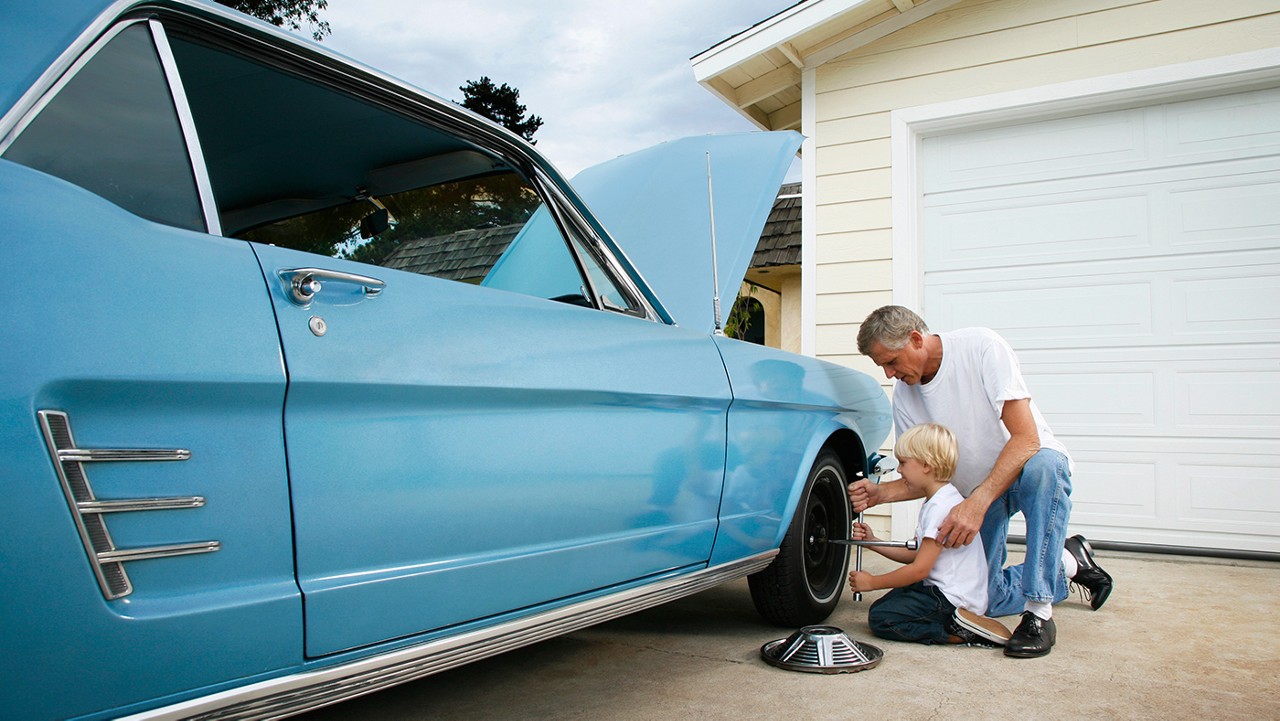To ensure you receive the best service possible,
please enter your zip code below:

This article is a comprehensive guide for classic and vintage car owners, covering everything from definitions and classifications to detailed care strategies. Topics include:

Owning a classic or vintage car is like holding a piece of history in your hands—it’s a passion that connects us to an era of automotive innovation and timeless design. Whether you’re showcasing your vehicle at car shows, taking it for a scenic drive or preserving it for generations to come, proper care and maintenance are essential to ensure its beauty and performance last.
This guide dives into everything you need to know about caring for your prized vehicle, from understanding classifications to implementing effective restoration and storage strategies.
NAPA Auto Parts offers AAA Members 10% off auto parts and tools in-store and online, making vehicle upkeep and maintenance affordable.
Locate a store near you
Classic cars are generally between 20 and 40 years old. Examples include a 1990s Porsche or a 2000s Mustang. These cars are often admired for their design, performance and cultural impact, making them regulars at car shows and occasionally featured on the open road.
Vintage cars specifically refer to automobiles manufactured from 1919 to 1930. Think of iconic models like the 1925 Ford Model T, which reflects the craftsmanship of its time.

Antique cars are vehicles over 45 to 50 years old, their age varying slightly by definition or state guidelines. Preserved for their historical significance, antique cars like the 1955 Chevrolet Bel Air are rarely driven and treasured for their ageless value.
Collector cars are cherished for their distinctive design, historical relevance or sentimental appeal. They may include classic, vintage or even newer models. Their value is determined by originality, craftsmanship, rarity and the passion they ignite among enthusiasts.
Restoring cars to their former glory—or enhancing them to reflect modern needs—requires thoughtful decisions and expertise. Identify the restoration type that matches your goals:
For rare classics or concours-level restorations, sourcing custom-fabricated parts is often essential, ensuring precise fit and authenticity. Aftermarket parts may be suitable for more accessible models or resto-mod builds, balancing quality and budget.
| Term | Definition |
|---|---|
| Historic vehicle | A catch-all often used for registration/insurance for cars over a certain age, like 25 years. |
| Resto-mod | A restored car with modern features added for safety, comfort, or performance. |
| Survivor car | A car that’s unrestored but in good, original condition. |
| Collector car | A broad term for vehicles that are prized for their rarity, design, or cultural value, regardless of age. |
| Muscle car | A performance-focused car, usually American-made and built between 1960s–1970s. |
| Modern classic | Newer cars (often 15–25 years old) that are expected to become collectible due to their design, performance, or limited production. |

Restoring a vintage car comes with a crucial decision—choosing between aftermarket parts or custom-fabricated components. Aftermarket parts are often the more budget-friendly and accessible option, especially for popular models like Mustangs and Camaros.
These parts can be suitable for driver-quality restorations or resto-mods when originality isn’t the primary focus. However, it’s important to note that aftermarket parts may not always meet the precise fit and finish standards of original pieces.
On the other hand, custom-fabricated parts are often the only option for rare vehicles or high-caliber restorations, such as concours-level rebuilds. These components adhere to exact original specifications or are specifically tailored for improved performance.
While this route ensures precision and authenticity, it typically involves a significantly higher cost and longer wait times, sometimes stretching into months.
Ultimately, the choice between aftermarket and custom-fabricated parts depends on your restoration goals, budget and timeline. If the project involves a rare or high-value vehicle destined for shows or collectors, investing in custom fabrication may well be worth the effort.
However, for more common classic cars that are intended for weekend drives or casual displays, high-quality aftermarket parts can deliver the desired results efficiently and affordably.

Whether you own a vintage auto, a classic car or something rarer, you’ll need to consider several factors: restoration, maintenance, cleaning, storage and use. For each of these factors, consider these care tips.
Routine care extends your car’s lifespan and preserves its striking appearance:
Invest in professional detailing services as needed and conduct thorough undercarriage cleanings, especially if the car is exposed to salty roads or harsh environments.
Does car color matter? Learn more about vehicle color and insurance, speeding tickets and more.
Read our articleCold temperatures, humidity, and direct sunlight can lead to all kinds of problems. Cold can cause mechanical problems, the sun can fade the paint and humidity can cause rust. Avoid all these problems by preserving your vehicle in a storage garage. The best space to keep your valuable automobile is one that’s dry, ventilated, insulated and temperature-regulated.
Intersted in exploring the world of classic cars? Check out these car museums in Florida, Michigan and Tennessee.

During off-season or long idle periods, it is good to do some pre-storage prep work to ensure your vintage vehicle is ready for hibernation.
Before you store the car, do a thorough cleaning, waxing, undercarriage wash and basic rust-proofing. This will keep everything protected while the vehicle is stored away. Here are a few additional tasks to undertake prior to storage:
Here are a few quick tips to consider before you rev up the engine after your car has been in storage. Items to check include:
Prioritize a light tune-up that includes checking or replacing:

Driving your vintage or classic car isn’t just a pleasure—it’s a necessity. Regular use prevents parts from drying out and keeps the engine in optimal condition. Before taking it out after storage, follow a seasonal pre-drive checklist to ensure brakes, tires, fluids and other essentials are in good shape.
Preserving a classic or vintage car is both an art and a labor of love. By combining regular maintenance with expert restoration and attentive storage practices, your treasured vehicle will remain a testament to motoring history and adventure for years to come.
Car maintenance
AAA Members receive a free vehicle maintenance inspection upon request with any paid service at a nearby AAA-owned Car Care center or AAA Approved Auto Repair facility, a 36-month/36,000-mile guarantee on repairs at AAA-owned Car Care locations, and a 24-month/24,000-mile warranty at AAA Approved Auto Repair facilities. Members also receive a 10% discount on repair labor (save up to $75).
A classic car is generally between 20 and 40 years old and is typically admired for its design, cultural value or performance. Examples include a 1990s Porsche or a 2000s Ford Mustang.
Vintage cars are specifically defined as vehicles manufactured between 1919 and 1930. The 1925 Ford Model T is a well-known example.
An antique car is usually over 45–50 years old, depending on the definition used by organizations or state DMV guidelines. Antique cars are often preserved for historical value and rarely driven.
Collector cars are valued for their rarity, design, or emotional appeal. They can be antique, vintage, classic or even newer models expected to increase in value due to limited production or cultural impact.
Use aftermarket parts if you want an affordable, accessible option for common models.
Choose custom fabrication if your car is rare or if precision and originality are top priorities.
Regular undercarriage cleaning, storing your car in a dry environment, and applying rustproofing products like Waxoyl or POR-15 can significantly reduce corrosion risk.
Store your vehicle in a dry, ventilated and temperature-controlled garage.
Driving your vintage car keeps rubber components flexible, prevents fluid breakdown and helps avoid mechanical problems caused by inactivity. Even short drives keep systems lubricated and seals intact.